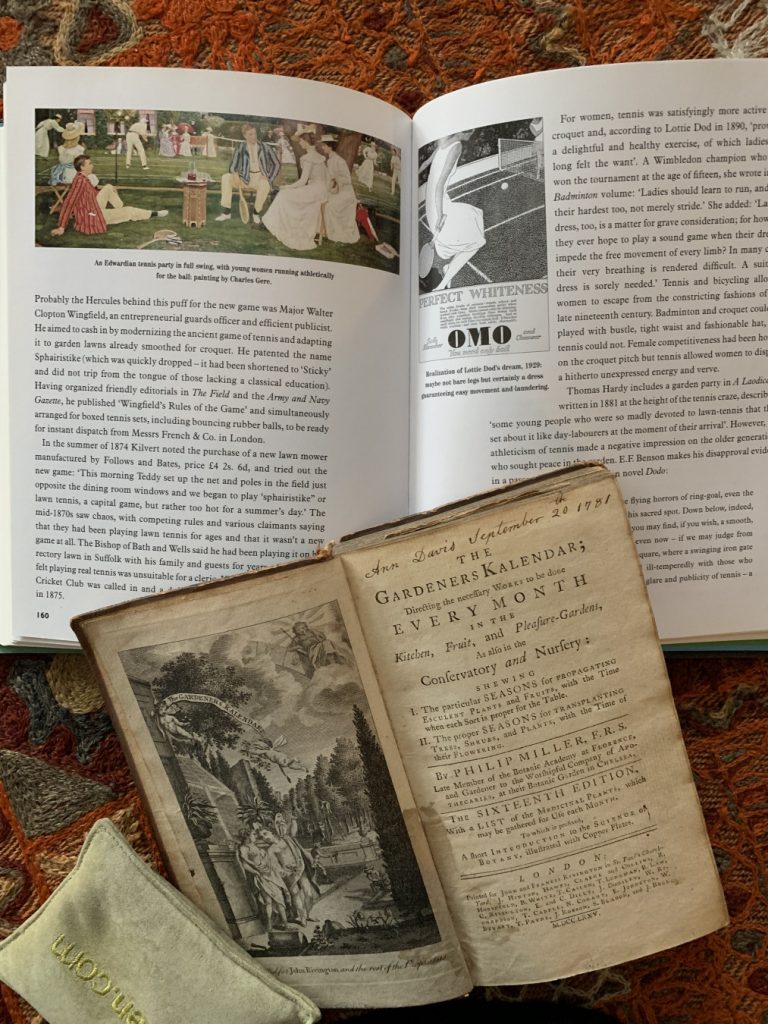What is a greenhouse to you: a hive of activity, or maybe a science lab? A place to grow strange and exotic plants, or an ER for houseplants that you really truly hope will revive in the moist humid enclosure where sunlight is abundant? And how about conservatory? Does that word conjure warm, quiet corners where uninterrupted hours of book reading are accepted, cups of Earl Grey are sipped, and lemon biscuits nibbled? Chintz-covered cushions, Parma violets and primroses, rose-scented geraniums and orange blossoms wafting sweet on the breeze. Yes? Then you’re singing my song. Hygge is what it is all about these worrisome days: Simple pleasures, simply enjoyed.

These past few weeks I’ve been spending a lot of time in my cozy fragrant nook, keeping social distance while sifting through a stack of books. Well…shelves of books actually. The voluntarily enforced seclusion has focused my mind on just how much stuff has silted up in our modest mid-century modern ranch house. My husband is a writer also and between us we’ve accumulated more books than you can shake a stick at: his about music and politics, mine about garden design, landscape history, art and architecture, and, okay I admit it, how to grow tomatoes in a gazillion different ways, each one guaranteed to bring success. Absolutely time to thin the herd.
Hauling the books from the dusty shelves has taken me through a time warp, revisiting my writing career through a Tardis of Titles, most collected with each new research project. If you’re sitting comfortably, I’ll begin. No, seriously – an especially artistic and precociously soignée friend in high school once said, “if you can read, you can do anything.” Probably not an original thought, but I was impressed. And found him to be right. Years later in England, I got into gardening and book collecting through the portal of scented gardens and a book of that name by H.L.V. Fletcher. It married practical advice with a guide to plants to grow, giving their history and that of perfumed gardens. I was hooked, and soon editing the book I developed and Rosemary Verey wrote, titled The Scented Garden. Rosemary’s library was densely packed with antique, Morocco-bound volumes seminal to the study of garden history; it was largely her impetus that gave the subject scholarly credibility on both sides of the Atlantic, and was the foundation of my learning about gardens and gardening history..

Since then I’ve acquired some choice books—like the four volume in Your Garden series by Vita Sackville-West, all first editions but rather beat up. Another one is the 4th edition of Perennials and Their Garden Habitat. First published in Germany prior to World War Two, and more recently by Cambridge University Press (there’s also a US edition from Timber Press), it pretty much inspired the New Perennial/Dutch Wave garden movement of today (think Highline in Brooklyn and Millennium Park in Chicago).
Garden how-to books are on the shelves of anyone who wants to grow something; I should know, I have dozens, many sent to me as review copies and spanning a couple of decades. It is fascinating to me how over centuries garden practice and fashion has swung like a pendulum, changing only in name. Like “regenerative gardening”, which as far as I can make out is all about crop rotation and manuring the ground (by running farm animals on it if you have them), encouraging birds, bats and bees to help control pests, and using other eco-friendly methods that have been a gardener’s way since at least the late medieval times. Example: In my library I have a lovely copy of The Gardeners Kalendar. The subtitle is lengthy because the content is thorough, covering garden tasks month by month, basic botany and all one might need to know for success in the “Kitchen, Fruit, Pleasure-Gardens, As Also in the Conservatory and Nursery”. Compiled by Dr Philip Miller, mine is the 16th edition and was published in London in 1775. This late edition includes a “List of medicinal Plants, which may be gathered for Use each Month”. This leads to me to believe it was marketed to women, as indeed my copy is inscribed Ann Davis, September 20th 1781. My point is that Miller goes into some detail about how to follow the regenerative gardening practice of that era, including adding manure to the soil by the agency of farm animals and their little hooves.

In closing (about time do I hear you say?) there is one book that is just simple pleasure and came to me a few months ago from the publisher Frances Lincoln. Written by Phillipa Lewis, the book is engagingly titled Everything You Can Do in the Garden Without Actually Trying. The chapter titled ‘Hammocks and Lounging About’ gives you the flavor of the content: rich with historical nuggets and whimsy and lots of archive illustration to back up the charm. Which is just what we need as we ready our gardens for summer in springtime’s socially-distanced solitude.
© Text and photos, Ethne Clarke, 2020.
Adding to the research of the original volume mentioned above, which covered the years from 1930 to 1975, a new volume of Historic Virginia Gardens has been published, written by Margret Page Bemiss and illustrated (beautifully) by photographer Roger Foley.
First published in 2000 by Frances Lincoln UK and Timber Press USA, copies of the original are available from secondhand dealers like the online source Abe Books.
Find out more about Phillippa Lewis’s gardening books and practice on her website, or chase down a copy of the Everything You Can Do in the Garden…


